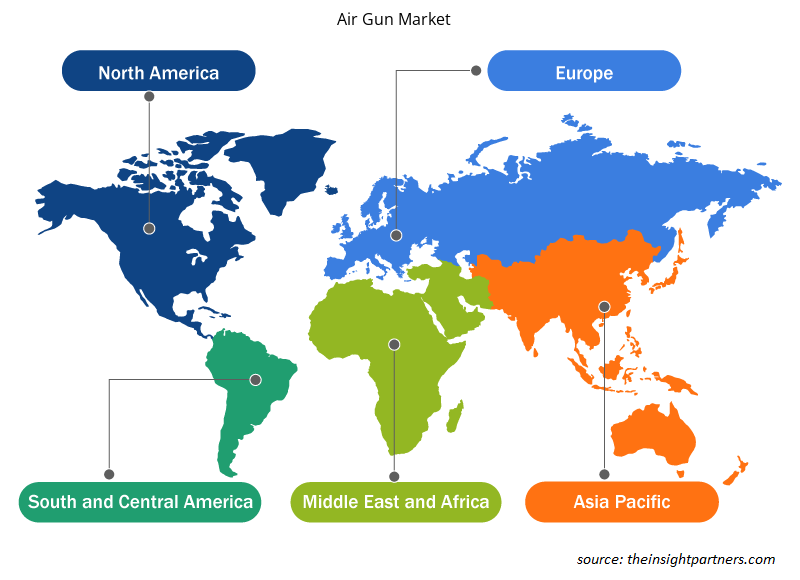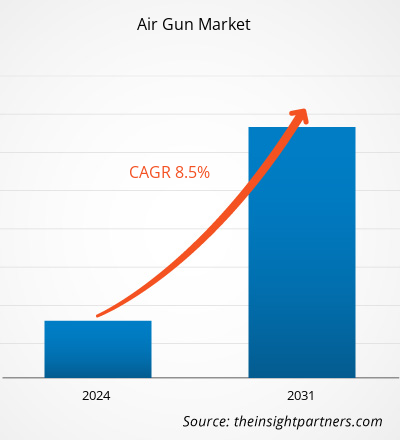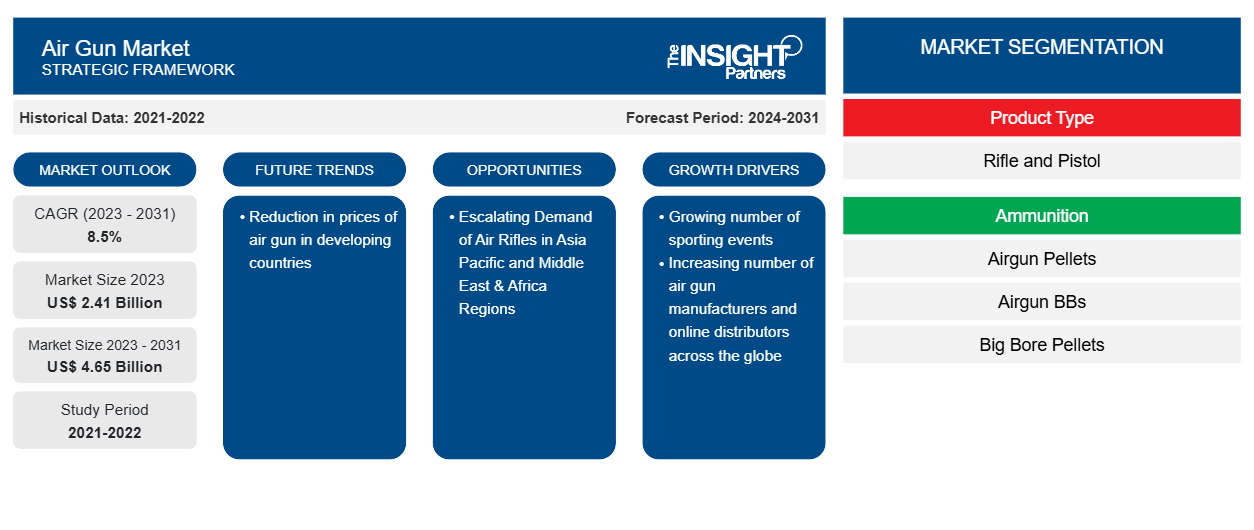Der Markt für Luftgewehre soll von 2,41 Milliarden US-Dollar im Jahr 2023 auf 4,65 Milliarden US-Dollar im Jahr 2031 anwachsen. Der Markt wird zwischen 2023 und 2031 voraussichtlich eine durchschnittliche jährliche Wachstumsrate von 8,5 % verzeichnen. Die Preissenkung bei Luftgewehren in Entwicklungsländern wird den Markt voraussichtlich antreiben und ein wichtiger Trend auf dem Markt bleiben.
Luftgewehr-Marktanalyse
Luftgewehre werden als Instrumente für die Jagd und das Schießtraining sowie als Spielzeug auf Jahrmärkten verwendet. Ein Luftgewehr ist ein Gerät, das ein Projektil pneumatisch mithilfe von Druckluft abfeuert, die mechanisch unter Druck gesetzt wird, ohne dass chemische Reaktionen auftreten. Luftgewehre gibt es in zwei Typen – Gewehre und Pistolen. Diese Produkttypen werden auch bei Schießwettbewerben für 10-m-Luftgewehr- und 10-m-Luftpistolenwettbewerbe verwendet. Die zunehmende Erschwinglichkeit von Hochleistungsluftgewehren ermöglicht große Projektile und größere Zielentfernungen für Wettkampfzwecke. Die Nachfrage nach Luftgewehren und Luftpistolen wird voraussichtlich mit der zunehmenden Verwendung unter den Menschen in den kommenden Tagen steigen, da die Zahl der Sportveranstaltungen, einschließlich Schießwettbewerben, zunimmt. So werden beispielsweise im US-Bundesstaat Arizona beim „Extreme Benchrest“-Wettbewerb Luftgewehre mit Kalibern bis zu 0,35 Zoll für Ziele in einer Entfernung von 75 und 100 Yards verwendet, während bei demselben Wettbewerb Luftgewehre mit großem Kaliber und Benchrest-Arm für Ziele in einer Entfernung von 35 bis 200 Yards eingesetzt werden.
Marktübersicht für Luftgewehre
Die Hersteller von Luftgewehren bieten Luftgewehre, Luftpistolen und Zubehör für Jagd und Schießsport an. Die Nachfrage nach Luftgewehren wird hauptsächlich durch neue Bestellungen für Luftgewehre für verschiedene Schießwettbewerbe angetrieben. In Nordamerika sind die USA Marktführer auf dem Luftgewehrmarkt. In Europa sind Frankreich, Deutschland und Großbritannien die wettbewerbsfähigen Länder, die die wichtigsten Importmärkte wie Spanien, Großbritannien und Irland bedienen. In APAC sind China, Indien und Singapur die bemerkenswerten Länder mit hohen Wachstumsraten in der Luftgewehrindustrie im Hinblick auf die Zunahme von Schießwettbewerben und die zunehmende Verwendung zur Schädlingsbekämpfung. Crosman Corporation, Air Force Airguns, Feinwerkbau GmbH, GAMO Outdoor, SLU gehören zu den größten Luftgewehranbietern, die weltweit tätig sind.
Passen Sie diesen Bericht Ihren Anforderungen an
Sie erhalten kostenlose Anpassungen an jedem Bericht, einschließlich Teilen dieses Berichts oder einer Analyse auf Länderebene, eines Excel-Datenpakets sowie tolle Angebote und Rabatte für Start-ups und Universitäten.
-
Holen Sie sich die wichtigsten Markttrends aus diesem Bericht.Dieses KOSTENLOSE Beispiel umfasst eine Datenanalyse von Markttrends bis hin zu Schätzungen und Prognosen.
Treiber und Chancen auf dem Luftgewehrmarkt
Immer mehr Hersteller und Online-Händler für Luftgewehre auf der ganzen Welt
Die Luftgewehrindustrie nimmt ordentlich Fahrt auf, und in den letzten fünf Jahren verzeichnen die Hersteller eine erhebliche Nachfrage nach ihren Produkten sowohl von Direktkunden als auch von Online-Händlern. Das Luftgewehr gilt nicht als Schusswaffe, und deshalb ist die Gründung neuer Produktionsstätten einfacher. Der globale Luftgewehrmarkt ist fragmentiert, mit einer beträchtlichen Anzahl von Akteuren, die weltweit tätig sind, und im Laufe der Jahre nimmt die Zahl der Hersteller zu. Die Zunahme der Hersteller beflügelt den globalen Luftgewehrmarkt, indem sie eine größere Anzahl von Produkten anbieten. Die USA und Europa haben die größte Überlastung in Bezug auf Luftgewehrhersteller; jedoch beobachtet auch die Region APAC derzeit ein Wachstum der Herstellerzahl. Zu den weltweit führenden Herstellern von Luftgewehren gehören unter anderem Air Force Airguns, Velocity Outdoor (Crossman Corporation), Smith & Wesson und GAMO Outdoor SLU. Andererseits tragen auch Online-Händler dazu bei, dass der Luftgewehrmarkt im Laufe der Jahre expandiert. Die Online-Händler ermöglichen es mehreren Kunden, ihre Luftgewehre oder Luftpistolen zu beziehen, wo es weniger Hersteller gibt. Darüber hinaus bieten Online-Händler ihre Produkte auch zu einem reduzierten Preis an, was Kunden anzieht und so die Marktgröße katalysiert. Zu den führenden Online-Händlern für Luftgewehre zählen unter anderem Airguns Europe, Pyramyd Air und Airgun Depot. Der Trend zum Online-Vertrieb verstärkt sich auch in den Entwicklungsländern, die den Kunden in diesen Ländern beim Kauf ihrer Waffen helfen und so das Wachstum des Luftgewehrmarktes fördern.
Steigende Nachfrage nach Luftgewehren im Asien-Pazifik-Raum sowie im Nahen Osten und Afrika
Die Nachfrage nach Luftgewehren wächst in der Region Asien-Pazifik aufgrund der zunehmenden Anzahl von Sportveranstaltungen sowie des wachsenden Interesses der Bürger an der Tierjagd schneller. Die Region Asien-Pazifik ist ein Paradies für Bergraubtiere, die eine große Vielfalt an Wildziegen und -schafen jagen können. Die Region bietet Jägern auch enorme Möglichkeiten, Hirsche, Gazellen, Bären, Rehe usw. zu jagen. In Australien, China, Japan und südostasiatischen Ländern ist die Jagd unter anderem legal. In Australien beispielsweise wird die Jagd von den einzelnen Territorien und Landesregierungen unabhängig geregelt, die unterschiedliche Gesetze, Lizenzanforderungen sowie Gebühren- und Bußgeldstrukturen anwenden. In Japan muss der Jäger mindestens 18 Jahre alt sein, um eine Lizenz zum Gebrauch von Luftgewehren und Projektilen (Gewehre und Schrotflinten) zu erhalten. Darüber hinaus sind für 2024 und 2025 mehrere Sportveranstaltungen geplant, bei denen Schießen eine der Sportarten in der Region ist, was den Marktanbietern in den jeweiligen Regionen wahrscheinlich neue Möglichkeiten eröffnen wird. Die steigende Nachfrage nach Luftgewehren in diesen Ländern sowie das zunehmende Interesse an Jagdspielen und Sportveranstaltungen beflügeln den Markt für Luftgewehre in allen APAC-Ländern mit Ausnahme von Indien.
Segmentierungsanalyse des Luftgewehr-Marktberichts
Wichtige Segmente, die zur Ableitung der Luftgewehr-Marktanalyse beigetragen haben, sind Produkttyp, Munition und Zubehör.
- Basierend auf dem Produkttyp ist der Luftgewehrmarkt in Gewehre und Pistolen unterteilt. Das Pistolensegment hatte im Jahr 2023 einen größeren Marktanteil.
- Basierend auf Munition ist der Luftgewehrmarkt in Luftgewehrpellets, Luftgewehr-BBs, Großkaliberpellets, Jagdpellets, Reinigungspellets und andere unterteilt. Das Segment der Luftgewehrpellets hatte im Jahr 2023 einen größeren Marktanteil.
- Basierend auf Zubehör ist der Luftgewehrmarkt in Zielfernrohre, Visiere, Halterungen, Ferngläser, Kompressoren und mehr unterteilt. Das Visiersegment hatte im Jahr 2023 einen größeren Marktanteil.
Luftgewehr-Marktanteilsanalyse nach Geografie
Der geografische Umfang des Luftgewehr-Marktberichts ist hauptsächlich in fünf Regionen unterteilt: Nordamerika, Europa, Asien-Pazifik, Naher Osten und Afrika sowie Südamerika.
Nordamerika dominierte den Markt im Jahr 2023, gefolgt von Europa und dem asiatisch-pazifischen Raum. Darüber hinaus wird der asiatisch-pazifische Raum in den kommenden Jahren wahrscheinlich die höchste durchschnittliche jährliche Wachstumsrate verzeichnen. Nordamerika besteht aus hochentwickelten Volkswirtschaften wie den USA und Kanada. Da das Bewusstsein für verschiedene Schießsportarten unter den Bürgern Nordamerikas hoch ist, nehmen viele Menschen an verschiedenen Schießsportarten mit Luftgewehren teil, darunter Bullseye-Schießen, Feldschießen, Schnellfeuer, praktisches Schießen, Tontaubenschießen, Benchrest, Vorderladerschießen, Plinking und andere. Die USA hatten im Jahr 2023 den größten Marktanteil am nordamerikanischen Luftgewehrmarkt. Die Gesetze zu Luftgewehren in Kanada besagen, dass der Kauf von Luftgewehren im Land nach dem 18. Lebensjahr legal ist. Wenn die Geschwindigkeit des Projektils eines Luftgewehrs mehr als 500 Fuß pro Sekunde beträgt oder wenn es eine Mündungsenergie von bis zu 5,7 Joule hat, gilt es als Feuerwaffe und muss gesetzlich registriert werden. Darüber hinaus sind Waffen mit einer Mündungsgeschwindigkeit von weniger als 366 Fuß pro Sekunde, die genauso konstruiert sind wie echte Schusswaffen, im Land verboten.
Regionale Einblicke in den Luftgewehrmarkt
Die regionalen Trends und Faktoren, die den Luftgewehrmarkt im Prognosezeitraum beeinflussen, wurden von den Analysten von Insight Partners ausführlich erläutert. In diesem Abschnitt werden auch die Marktsegmente und die Geografie des Luftgewehrmarkts in Nordamerika, Europa, im asiatisch-pazifischen Raum, im Nahen Osten und Afrika sowie in Süd- und Mittelamerika erörtert.

- Holen Sie sich regionale Daten zum Luftgewehrmarkt
Umfang des Luftgewehr-Marktberichts
| Berichtsattribut | Details |
|---|---|
| Marktgröße im Jahr 2023 | 2,41 Milliarden US-Dollar |
| Marktgröße bis 2031 | 4,65 Milliarden US-Dollar |
| Globale CAGR (2023 - 2031) | 8,5 % |
| Historische Daten | 2021-2022 |
| Prognosezeitraum | 2024–2031 |
| Abgedeckte Segmente |
Nach Produkttyp
|
| Abgedeckte Regionen und Länder |
Nordamerika
|
| Marktführer und wichtige Unternehmensprofile |
|
Dichte der Marktteilnehmer für Luftgewehre: Auswirkungen auf die Geschäftsdynamik verstehen
Der Markt für Luftgewehre wächst rasant, angetrieben durch die steigende Nachfrage der Endnutzer aufgrund von Faktoren wie sich entwickelnden Verbraucherpräferenzen, technologischen Fortschritten und einem größeren Bewusstsein für die Vorteile des Produkts. Mit steigender Nachfrage erweitern Unternehmen ihr Angebot, entwickeln Innovationen, um die Bedürfnisse der Verbraucher zu erfüllen, und nutzen neue Trends, was das Marktwachstum weiter ankurbelt.
Die Marktteilnehmerdichte bezieht sich auf die Verteilung der Firmen oder Unternehmen, die in einem bestimmten Markt oder einer bestimmten Branche tätig sind. Sie gibt an, wie viele Wettbewerber (Marktteilnehmer) in einem bestimmten Marktraum im Verhältnis zu seiner Größe oder seinem gesamten Marktwert präsent sind.
Die wichtigsten auf dem Luftgewehrmarkt tätigen Unternehmen sind:
- Luftgewehre der Luftwaffe
- Carl Walther GmbH
- Daisy Outdoor Products Inc.
- Feinwerkbau GmbH
- GAMO OUTDOOR, SLU
Haftungsausschluss : Die oben aufgeführten Unternehmen sind nicht in einer bestimmten Reihenfolge aufgeführt.

- Überblick über die wichtigsten Akteure auf dem Luftgewehrmarkt
Neuigkeiten und aktuelle Entwicklungen auf dem Luftgewehrmarkt
Der Luftgewehrmarkt wird durch die Erhebung qualitativer und quantitativer Daten nach Primär- und Sekundärforschung bewertet, die wichtige Unternehmensveröffentlichungen, Verbandsdaten und Datenbanken umfasst. Nachfolgend sind einige der Entwicklungen auf dem Luftgewehrmarkt aufgeführt:
- Compass Diversified (NYSE: CODI) („CODI“ oder das „Unternehmen“), Eigentümer führender mittelständischer Unternehmen, gibt den gleichzeitigen Abschluss einer endgültigen Vereinbarung (die „Vereinbarung“) und den Abschluss des Verkaufs der Crosman Corporation („Crosman“), der Luftgewehrabteilung seiner Tochtergesellschaft Velocity Outdoor, Inc., an die Daisy Manufacturing Company („Daisy“) bekannt. (Quelle: Compass Diversified, Pressemitteilung, April 2024)
- Air Venturi, der führende Hersteller und Importeur von Luftgewehren, Airsoft- und Munitionsmarken, hat gerade das Dragonfly Mk2 als spannende Ergänzung seiner Palette an Sportluftgewehren angekündigt. (Quelle: Air Venturi, Pressemitteilung, Januar 2022)
Marktbericht zu Luftgewehren – Umfang und Ergebnisse
Der Bericht „Marktgröße und Prognose für Luftgewehre (2021–2031)“ bietet eine detaillierte Analyse des Marktes, die die folgenden Bereiche abdeckt:
- Luftgewehr-Marktgröße und Prognose auf globaler, regionaler und Länderebene für alle wichtigen Marktsegmente, die im Rahmen des Berichts abgedeckt sind
- Luftgewehr-Markttrends sowie Marktdynamik wie Treiber, Einschränkungen und wichtige Chancen
- Detaillierte Porter-Fünf-Kräfte-Analyse
- Analyse des Luftgewehrmarkts mit Blick auf wichtige Markttrends, globale und regionale Rahmenbedingungen, wichtige Akteure, Vorschriften und aktuelle Marktentwicklungen
- Branchenlandschaft und Wettbewerbsanalyse, einschließlich Marktkonzentration, Heatmap-Analyse, prominenten Akteuren und aktuellen Entwicklungen auf dem Luftgewehrmarkt
- Detaillierte Firmenprofile
- Historische Analyse (2 Jahre), Basisjahr, Prognose (7 Jahre) mit CAGR
- PEST- und SWOT-Analyse
- Marktgröße Wert/Volumen – Global, Regional, Land
- Branchen- und Wettbewerbslandschaft
- Excel-Datensatz
Aktuelle Berichte
Verwandte Berichte
Erfahrungsberichte
Grund zum Kauf
- Fundierte Entscheidungsfindung
- Marktdynamik verstehen
- Wettbewerbsanalyse
- Kundeneinblicke
- Marktprognosen
- Risikominimierung
- Strategische Planung
- Investitionsbegründung
- Identifizierung neuer Märkte
- Verbesserung von Marketingstrategien
- Steigerung der Betriebseffizienz
- Anpassung an regulatorische Trends























 Kostenlose Probe anfordern für - Luftgewehrmarkt
Kostenlose Probe anfordern für - Luftgewehrmarkt